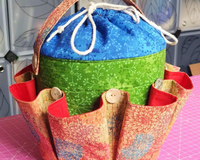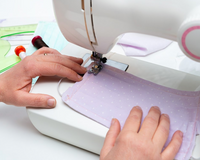Fabric interfacing is a material used to provide structure, stability, and reinforcement to fabrics in sewing projects.
It is often used on areas such as collars, cuffs, waistbands, and buttonholes to give them shape and support.
There are several types of fabric interfacing available, each with its own characteristics and benefits. Here are some common types:
-
Woven Interfacing: This type of interfacing is made from a woven fabric, typically cotton or polyester. It provides moderate support and stability while maintaining flexibility. Woven interfacing is suitable for a wide range of fabrics and is commonly used in dressmaking, quilting, and other sewing projects. Shop our Woven Interfacing HERE
-
Non-Woven Interfacing: Non-woven interfacing is made from fibres bonded together using heat, chemicals, or mechanical processes. It is available in various weights and thicknesses, ranging from lightweight to heavy-duty. Non-woven interfacing is easy to use, provides stability, and is often used in projects where a stiffer finish is desired, such as bags, hats, and home decor items.
-
Fusible Interfacing: Fusible interfacing has a layer of adhesive on one side, which can be activated with heat from an iron to bond it to the fabric. It eliminates the need for stitching and provides a smooth and seamless finish. Fusible interfacing is available in woven and non-woven varieties and is commonly used in garment construction, especially for lightweight and medium-weight fabrics.
-
Knit Interfacing: Knit interfacing is made from a stretchable material, such as polyester or spandex, and is used when the fabric being interfaced is also stretchy. It provides support and stabilization while allowing the fabric to retain its stretchiness. Knit interfacing is commonly used in knit garments, stretchy fabrics, and areas that require flexibility, like waistbands and cuffs.
-
Sheer Interfacing: Sheer interfacing is a lightweight and transparent type of interfacing. It is used when minimal structure or support is needed while maintaining the drape and hand of the fabric. Sheer interfacing is often used with delicate fabrics, such as chiffon, silk, or lace, where it provides stability without adding bulk or altering the fabric's appearance.
The benefits of fabric interfacing include:
-
Structure and Stability: Interfacing helps fabrics hold their shape, providing support to areas like collars, cuffs, and waistbands. It prevents them from sagging or losing their form over time.
-
Reinforcement: By adding an extra layer of interfacing, fabrics become more resistant to wear and tear, extending the lifespan of garments or other sewn items.
-
Ease of Sewing: Interfacing makes fabrics easier to handle during the sewing process, especially when working with delicate or slippery materials. It can prevent stretching, distortion, or puckering.
-
Professional Finish: Interfacing can give a polished and professional look to garments, bags, and accessories. It helps achieve clean lines, crisp edges, and smooth curves.
-
Versatility: With various types and weights available, fabric interfacing can be tailored to specific project requirements. Different interfacing options allow for customisation based on the fabric type, desired stiffness, and desired level of support.
It's important to choose the appropriate interfacing type and weight for your specific project, considering the fabric type, desired level of support, and the overall effect you want to achieve.




